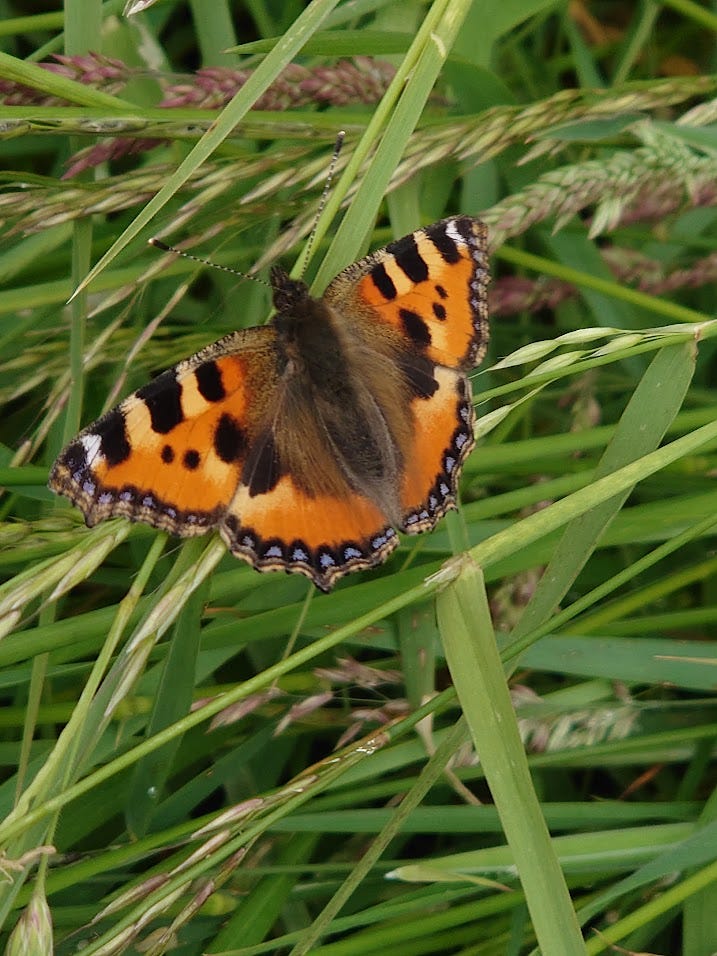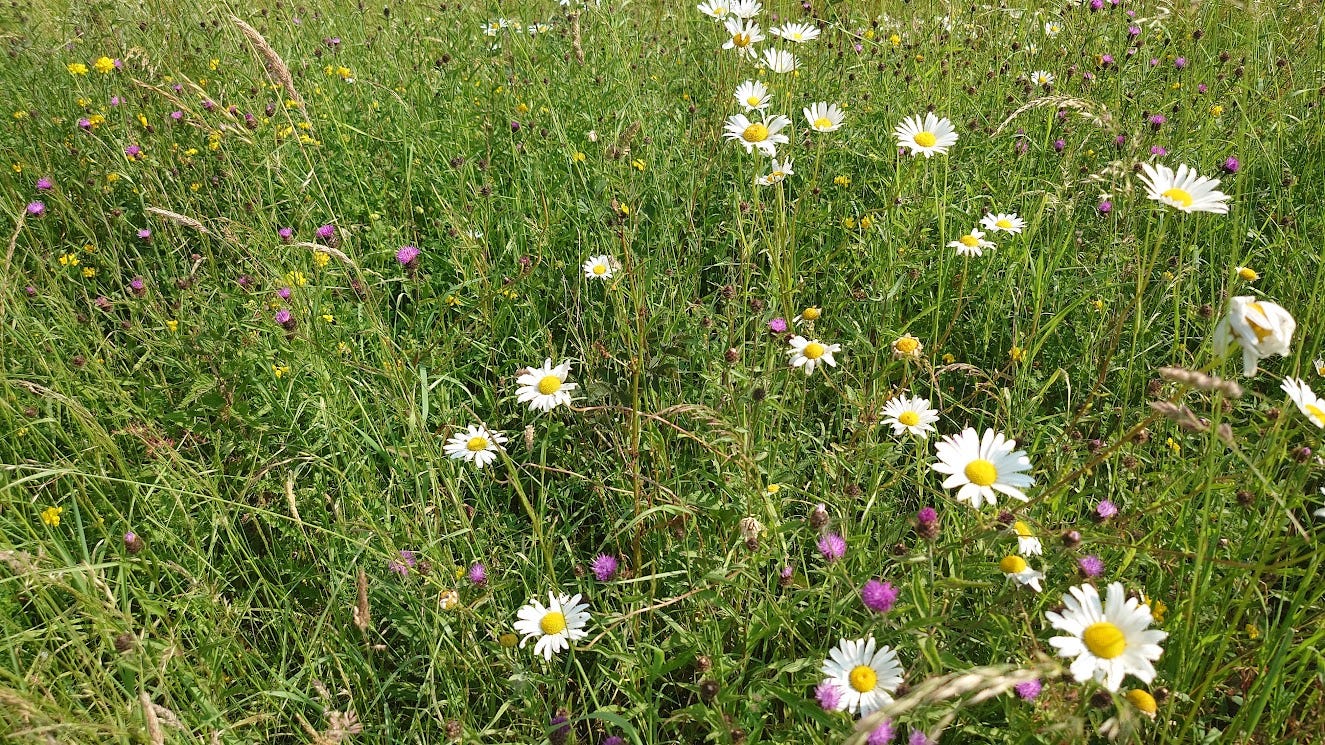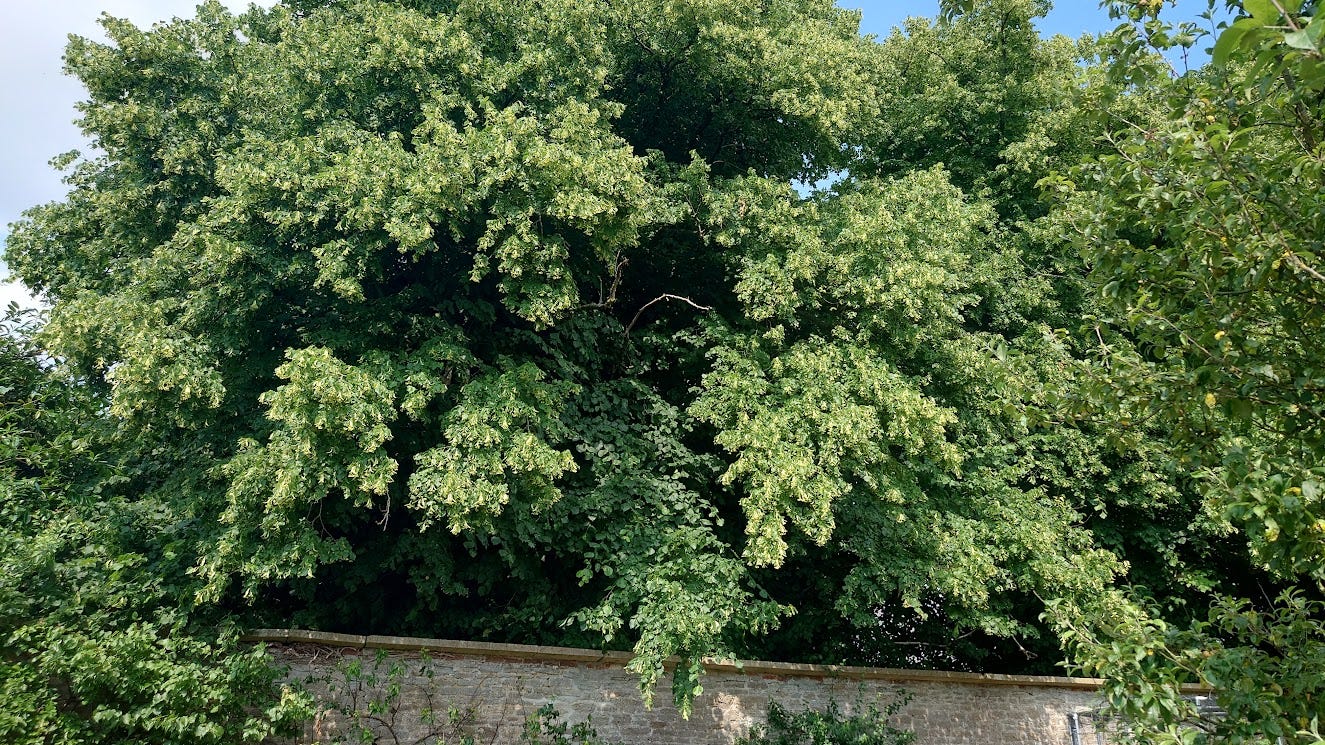Where are all the butterflies?
Are you worried by the lack of insects this year? We're enjoying lovely sunny weather but there's hardly a butterfly on the wing in our fields. Plus some thoughts on soil health, no-dig and rhizophagy
It’s National Insect Week ( 24-30 June) in the UK, organised by the Royal Entomological Society, a week to celebrate all things insect. It’s also my favourite week on the farm as our meadows are at their best. But not this year. I don’t think I have felt quite so depressed when walking around our fields for a long time - glorious sunny weather and hardly a butterfly on the wing.
Looking back over my IG posts, this time last year I wrote: It's peak time for butterflies We have lots of meadow browns, ringlet, comma, small whites, small tortoiseshell, peacock, blues at the moment, plus dragonfly and damselflies. Plus there were videos of my lavender border in the garden with clouds of meadow browns on the wing.
Well one year later, the meadows (above) are looking much as expected with plenty of knapweed which usually draws in the butterflies. I have seen meadow browns, ringlets, a few marble whites, large skippers and small whites. But none in significant numbers – just a couple at a time.
The cause?
It has to be the weather. We have just come through the wettest 18 months on record and many of our fields have been waterlogged for weeks at a time. Plus the lack of sun in May. So, when you look at the life cycle of the meadow brown, you can see where the problem lies. The female lays her eggs amongst the grass where the larvae feed for the rest of summer and into autumn, then overwinter amongst tussocks of grass. They may emerge on warm winter days to feed, but become active in spring before pupating. I am hopeful that the long, cold spring has put their cycle back a few weeks and they will still emerge, but by then the hay will have been cut.
The marbled white is also dependent on unimproved grassland. The tiny larvae hatch from eggs in summer and spend the rest of the year hibernating in the base of a clump of grass. They become active in spring to feed and continue development before pupating in May and emerging in mid June onwards. Again, I am hopeful that they are late, but their favourite flower, the knapweed, will be at the end of its flowering season.
The marbled white is a conservation success story. I have seen numbers on our fields rise from nothing in 2005-7 to numerous in 2023, and its not unusual to spot 10+ individuals on a single knapweed plant. Generally, this species has extended its range and is far more abundant, with numbers up more than 50% compared with 1976. So, I just hope that numbers bounce back in the coming years. At least I have spotted a few on the wing …...
No small tortoiseshells
I’ve not seen any small tortoiseshells this year. Have you? You may have read the Butterfly Monitoring Scheme report which showed that 2023 was its worst year on record. Once a common garden visitor, it is now a species of conservation concern, with abundance down 82% since 1976.
Citizen science
I get worried when I don’t see butterflies as they are critical environmental indicators. Their short life cycles and dependency on specific habitats and food plants mean that they respond quickly to environmental stress, like climate change, so researchers use them as indicators.
I always submit records to the Big Butterfly Count (12 July – 4 August) but if you have time you could get involved with the UK Butterfly Monitoring Scheme so that ecologists can track what’s happening to our butterflies. I have a horrible feeling that the UK Butterfly Monitoring Scheme report for 2024 will be a depressing read.
Its not just butterflies. I haven’t seen many solitary bees or indeed, honey bees, despite have hives on the farm. I have three magnificent lime trees at the end of the garden and they are laden with flowers. Standing under the trees, I would normally be deafened by the buzzing. Not so today. There was buzzing, but nowhere near the usual volume.
Hornets
But on a brighter note, I was buzzed by a hornet this morning. No - its not the invader but the native European hornet (Vespa crabro). Such a wonderful insect. This one was visiting hogweed flowers but its also predatory, taking beetles, moths and even dragonflies. I have seen a few around but I don’t know where they are nesting. I just hope its in the nearby woodland and not in my neighbour’s roof space because he wont let them stay ...
Groundswell
This is a major event in the farming calendar aimed at regenerative farmers. Taking place over two days (26/27 June) near Hitchin, there are loads of talks, seminars, walks covering soil, no-till, cover crops, livestock, helping farmers to improve soil health. I’ve not been for a few years, but I listen to the talks when the recordings appear on the Groundswell website in the coming weeks. It may be about farming, but there is so much that gardeners and allotmenteers can learn about the soil, using green manures, planting trees and more.
One of the keynote speakers this year is John Kempf from the USA. John is a teacher, speaker, and designer of innovative soil and plant management systems. I listen to his podcasts and some of the stuff he talks about really blows your mind.
I am just going to give you a taster. His recent podcast was in conversation with regenerative farmer Rick Clarke and they were discussing the legacy of soil guru Christine Jones (and if you haven’t read her work – please check her out). One of the topics they covered was tilling vs herbicides.
As a bit of background, many farmers in the UK and US have abandoned the plough and moved to no-till to protect the soil, direct sowing cover crops after harvesting their crops to protect the soil over winter. All good stuff. But there is an issue – how do you get rid of the cover crop in spring? One option is to grow crops that are killed by frost so they die and leave a mulch over the surface. Annual ryegrass and buckwheat are two examples. Or you can cut them hard or damage them with a crimping tool on a frosty morning. But many regenerative farmers opt to terminate the cover crop using glyphosate. The tell-tale sign of glyphosate use is a parched yellow field in spring where the cover crop has been sprayed off.
Its long been thought that the damage from glyphosate is less than that done by ploughing, since ploughing is known to destroy soil aggregates, which leads to poorer soil structure. It also damages the soil microbiome, especially the fungal hyphal network.
Not so, according to Christine Jones. Shallow tillage (no more than 6 inch) is better than using glyphosate. Shallow tillage will chop the fungal hyphae into shorter lengths but they can still recolonise the next generation of plants. So the key is, you can min-till so long as you replant or sow after tilling! They also mentioned that if you pull out a plant, its microbiome remains in the ground and will populate the roots of any new plant put in its place.
OK so now my mind was reeling and I have to do some more research, but it’s interesting stuff!
So what about no dig in the garden?
I have long been a no dig gardener but listening to John and Rick’s conversation made me wonder about my own soil. Is digging as bad for the soil as we’ve been told? What if I shallow dig and replant or reseed the soil. Will the fungal strands repopulate the soil and plant roots? They also mentioned that this benefit lasts a while – so if you have a cover crop that is killed by winter weather, the benefits of the root biome will last over winter until you sow or plant in spring.
Rhizophagy
Hardly a month goes by without a new research paper being published about the interactions between soil, microbes and plants that takes place in the rhizosphere (the zone around the roots).
Plants feed the microbiome with their carbon-rich exudates from their roots. By altering the composition of their exudate, they can influence which microbes populate the soil around their roots.
One new area of research is rhizophagy (root eating) We are learning that plants can cultivate symbiotic microbes and extract nutrients from them. The symbiotic bacteria and fungi flip between a free-living phase in the soil and a plant-dependent stage in the the root hair of a plant. The microbes take up nutrients from the soil, enter the root hair where the nutrients are extracted and then they return to the soil.
We also know that plants, not necessarily the same species, growing close to each other can share microbes. Researchers have found that when conditions are good there is less sharing, but stressful conditions, such as drought, trigger sharing!
We have so much to learn about plants and their relationship with the soil microbiome.
Next week
My polyculture beds and how I choose which plants to grow together, plus some thoughts on transferring microbes via seeds
Happy Gardening
Sally
Events and talks
RHS Hampton Court If you are visiting the festival next week, come and listen to our talks, Sally is talking on Thursday 4 July and Kim is at the festival on Saturday 6 July
London Permaculture Festival, Sunday 7 July 11 am - 6pm
If you live in London or nearby, come along to the Festival - it really is a great day out with lots of speakers, stalls, Chelsea Green bookstall, and lots of activities for families. Sally is speaking on creating a resilient garden.








